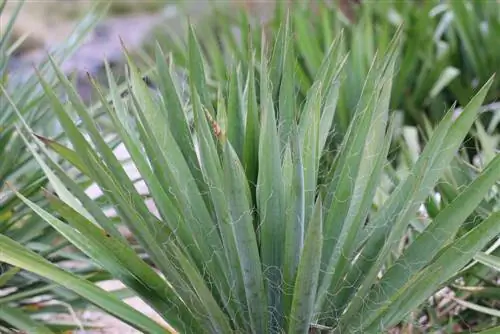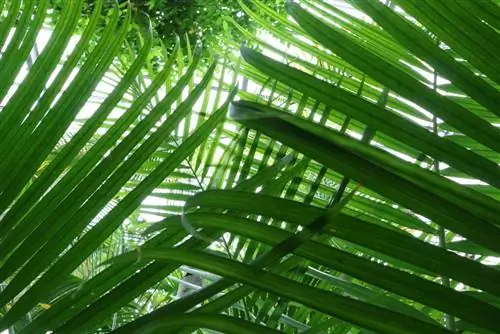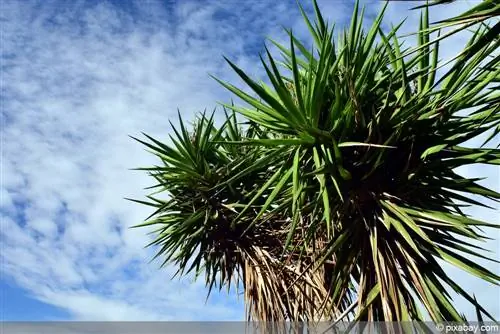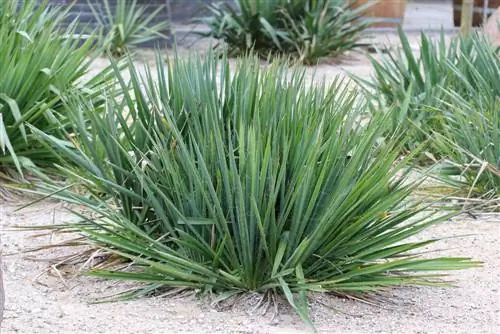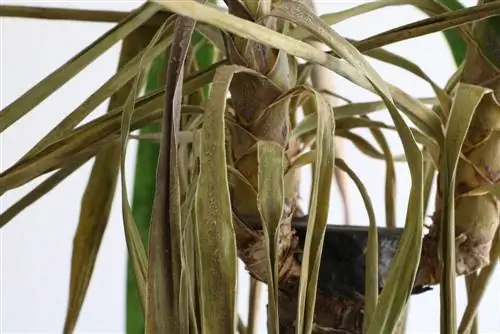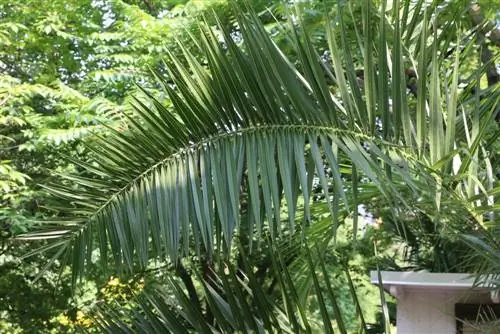- Author admin [email protected].
- Public 2023-12-17 03:39.
- Last modified 2025-01-24 12:45.
The huge flowers take your breath away when they rise above the mighty leaves in summer. Decorated all over with graceful bells in an elegant creamy white, the decorative value of a garden Yucca Filamentosa during the flowering period can hardly be surpassed. Thanks to its majestic habit, evergreen foliage and robust winter hardiness, the palm lily stands out decoratively in the garden at any time of the year. The following lines will tell you how much care the agave plant requires for this masterpiece and how the stemless plant should be cut.
Location
By choosing the location, you define the actual scope of care for a palm lily. At the same time, an adequate location serves as a springboard for magnificent growth, which results in early flowering, which would otherwise only appear at an advanced age.
- Full sunny, warm location
- No risk of cold drafts or strong winds
- Ideally protected by a wall, a high fence or a pergola
Congested heat in summer is no more a problem for the garden yucca than full sunshine. On the contrary, the exotic agave really comes to life under tropical weather conditions.
Soil conditions and substrate
In rockeries, steppe heaths, rocky areas and gravel beds right through to prominently located beds, the monumental Yucca Filamentosa serves as the dominant accent plant. It fulfills this task more effectively the better the soil is tailored to its requirements. The following attributes are important:
- Sandy-loamy garden soil, poor and permeable
- Humos, dry and well-drained
- Neutral to slightly calcareous
In the bucket, the first thing to consider is good potting soil, which is optimized by adding sand, perlite, lava granules or expanded clay. Conventional potting soil, on the other hand, tends to quickly become compacted, which would cause the roots to rot within a short time.
Tip:
Cautious hobby gardeners place palm lilies in the pot on special feet so that excess irrigation water can drain off better and additional ventilation takes place from below.
Watering and fertilizing
A supportive water supply is only required during the phase during which a young garden Yucca Filamentosa is growing. Once the roots have taken hold, they make do with the natural rainfall. However, if there is a summer drought, the palm lily is watered thoroughly when the substrate surface has dried out. In the bucket, however, the water requirement turns out to be higher, given the limited volume:
- Water the garden yucca in the planter regularly after a thumb test
- Administer a slow-release fertilizer at the start in spring
- Alternatively, from March to July, incorporate compost, horn shavings or granulated cattle dung every 4 weeks
- Do not apply fertilizer from August onwards so that the palm lily can mature before winter
A palm lily in a pot is supplied with a liquid preparation or fertilizer sticks once a year. In the year of planting or after repotting, additional nutrient supply is unnecessary as the substrates are usually sufficiently pre-fertilized.
Tip:
Repeated watering with pond water eliminates the need to add fertilizer due to the natural nutrient content.
Cutting
One of the typical characteristics of a garden Yucca Filamentosa is its stemless habit. It is therefore clear at first glance that pruning is not necessary according to the classic understanding. For visual reasons, removing dried leaves is recommended. Cut these off with a sharp knife. Since there is a residue left on the plant that could rot, you can optionally tear off the sword leaf with a jerk. When doing this work, wear sturdy work gloves to avoid injuring yourself on the sharp edges of the blade.
If the impressive flower has withered in July or August, it is cleaned out. However, do not undertake this care work hastily. With a little luck, you'll also see decorative capsule fruits that also contain seeds for propagation.
Wintering
An established palm lily can easily withstand frosty temperatures down to -30 degrees Celsius. Winter protection is only beneficial outdoors in the year of planting.
- Tie the leaves together before the first frost
- Put a jute sack or garden fleece over it
- Cover the root area with pine fronds, straw or brushwood
- If there is a clear frost, water a garden yucca a little on a frost-free day
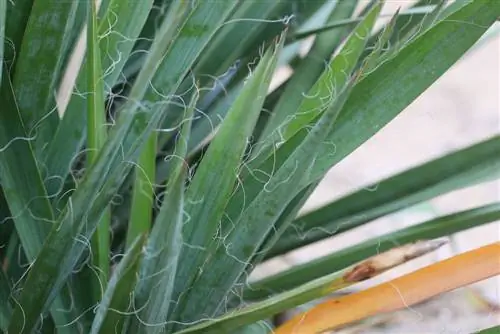
Potted plants move to frost-free winter quarters every year. Due to the exposed position of the root ball in the planter, there is a high risk of it freezing. Where space is limited, the pot should at least be placed on an insulating material, such as wood or Styrofoam. Additionally, a bubble wrap cover keeps icy winter storms at bay. A thick layer of leaves protects the substrate.
Tip:
Do not allow palm lilies to dry out completely in their winter quarters. To protect against spider mites or other pests, spray with water every now and then.
Repotting
If the roots protrude from the bottom opening of the pot or push through the substrate, you can no longer avoid repotting. A suitable time for this care measure is early spring, shortly before new growth. You can do it in these steps:
- Put on robust work clothing, gloves and safety glasses
- In the new bucket, create a 5-10 cm high drainage made of gravel, grit or pottery shards
- Fill the recommended substrate halfway
- Unpot the palm lily and place it in the middle of the new pot
- Fill the cavities with soil and press down repeatedly with your fist
Fill the potting soil only high enough to leave a watering edge. Then water the repotted palm lily thoroughly. The transplanting procedure also offers an excellent opportunity to take a closer look at the root ball. Cut out rotten and severely twisted root strands with a sharp, disinfected knife.
Propagate
If you would like more specimens of a garden Yucca Filamentosa, you can choose from various methods of propagation:
Kindel
A palm lily ensures its own reproduction in two ways: on the one hand, it produces berries with seeds and, on the other hand, it allows daughter plants to flourish at the base. These Kindel are fully developed young plants with exactly the attributes of their mother plant. This is how they are used for breeding:
- In the fall, choose children with a height of at least 20 centimeters
- Separate from the mother plant with a sharp knife or a courageous spade stab
- Planting in a large pot with nutrient-poor, sandy substrate
- Water occasionally in a bright location at 5-10 degrees Celsius
By next spring, the daughter plants will have developed their own root system and will be planted out.
Sowing
The seeds for propagation come from the autumn berries, which, of course, only rarely form in these latitudes. Alternatively, specialist retailers have a corresponding offer available.
- In February or March, soak the seeds in lukewarm chamomile tea for 12 hours
- Fill the cultivation pots with seed soil or peat sand and moisten with a fine spray
- Press 1-2 seeds into the substrate at a time
- A glass or foil cover accelerates germination
At temperatures of at least 20 degrees Celsius in a partially shaded location, keep the substrate only slightly moist without causing waterlogging. If germination begins, the cover has fulfilled its duty. The young palm lilies are mature enough to be planted outdoors or in pots from a height of 20 cm.
Conclusion
The majestic size of a garden Yucca Filamentosa presents a greater challenge than the actual care. This is limited to the careful choice of a location that is as sunny, warm and protected as possible with lean, permeable soil. Regular watering is only necessary during the growing phase or during dry summers. Fertilizing is limited to a starter fertilization in spring or an occasional portion of compost. Since the palm lily thrives in the garden without a stem, cutting is limited to removing withered leaves and wilted flowers.

